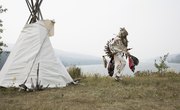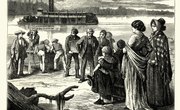Before the year 1800, most of the population of the United States lived on the eastern seaboard of North America. In the early 1800's, however, many Americans began to move west. Important events like the Louisiana Purchase, along with a desire for more farmland, prompted westward expansion. By the year 1820, Americans had heavily settled land as far west as the Mississippi River, and created numerous new states in the process.
Appalachian States
The first region west of the original thirteen states that was heavily settled was the Appalachian mountain region, including Tennessee and Kentucky. Unlike other parts of the United States, the Appalachian region was largely populated by Scotch-Irish immigrants. This contributed to the region's distinct culture, which includes Celtic-influenced country music. Though Kentucky and Tennessee were admitted to the Union in 1792 and 1796 respectively, their populations did not grow heavily until a decade later. By the year 1800, 10% of all American citizens lived west of the Appalachian Mountains in Tennessee, Kentucky and parts of modern-day West Virginia.
The Old Northwest
The Old Northwest refers to parts of the modern "Midwest," including the states of Ohio, Indiana and Illinois. This region of the country was settled heavily between 1800 and 1820, though its settlers were from many different parts of the country. Ohio, for example, was largely populated by migrants from New England, and most of the state was settled by 1820. Some migrants also came from the Southern states. Indiana, for example, was mostly settled by Southern migrants coming from North Carolina and Virginia. Illinois' settlers were very diverse, coming from New England, the South, and Appalachia. Abraham Lincoln's family, for instance, moved to Illinois from Kentucky in 1830. Ohio, Indiana and Illinois were admitted to the Union as states in 1803, 1816 and 1818 respectively.
Gulf Coast
Congress first organized the Mississippi Territory in 1798, which allowed Americans to settle in the region. The territory, located along the Gulf Coast and the Mississippi River, had extremely rich soil suitable to cotton production. The invention of the cotton gin, which made the crop's production more efficient, spurred increased demand in productive soil. As such, Southerners from Georgia and the Carolinas poured into the region, bringing their cotton-harvesting slaves with them. The states of Mississippi and Alabama were soon formed in 1817 and 1819, and became states whose populations were composed roughly half of people who were slaves and half of people who were free.
Farther West
While the Gulf Coast, the Old Northwest and Appalachia formed the bulk of major American settlements in the early 1800's, a few Americans dared to venture farther west. The Lewis and Clark Expedition was actively exploring the new Louisiana Purchase, and Americans were enticed to begin settling in places that would soon become the states of Missouri, Arkansas, Wisconsin, Michigan and Minnesota. In Minnesota and Wisconsin, which were admitted into the Union in 1858 and 1848 respectively, for example, German and Scandinavian immigrants found the cold climate similar to their European homes. They slowly built small settlements in the region, while slaveholding farmers also built small villages in places like Arkansas. Americans were unquestionably on the move, with some heading gradually west.
Related Articles
References
Writer Bio
Kevin Wandrei has written extensively on higher education. His work has been published with Kaplan, Textbooks.com, and Shmoop, Inc., among others. He is currently pursuing a Master of Public Administration at Cornell University.











